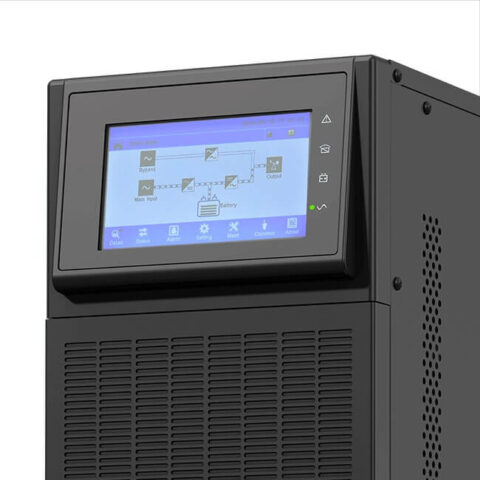Summary
LCD displays on UPS systems are far from cosmetic. They provide real-time data, fault diagnostics, and load insights that LED-only models can’t match, especially in tender-grade, remote or critical infrastructure setups. For projects requiring visibility, logs or onsite troubleshooting, an LCD is not a bonus feature but a functional requirement.
Introduction
If you’re preparing a tender for a UPS installation in a remote, regulated or mission-critical site, display visibility might seem like a minor detail. But when the system trips, the grid drops, or a field tech arrives after-hours, being able to read clear, local status data matters.
LCD screens on UPS units have become increasingly standard, but are they operationally necessary? Or are LED indicators, remote dashboards, and SNMP cards enough?
In this post, we’ll help you determine:
- When an LCD adds measurable value in uptime planning
- What LCD vs LED displays show (and hide)
- Whether a non-LCD unit may meet compliance needs
- What tender clauses typically require for diagnostics and visibility
Whether you’re selecting for a mining shelter, NDIS health site or 5G cabinet, understanding the difference between LED blinks and LCD panels could shape both your maintenance workflow and spec success.
Let’s break it down with real product data and engineering-backed insights.
What Does an LCD Screen Tell You About Your UPS?
UPS LCD panels aren’t decorative. For infrastructure planners and field techs alike, they serve as a primary interface for assessing the UPS’s health and operational state, especially in environments where network tools are unavailable or restricted.
Here’s what a UPS with an LCD panel can reveal:
- Battery Health and Charge Level: Live updates on voltage, charge percentage, and sometimes estimated runtime remaining.
- Input and Output Metrics: Voltage, frequency, and power factor data help validate site power quality and UPS performance.
- Load Monitoring: Displayed as percentages or bar graphs, useful for avoiding overcapacity scenarios.
- Event Notifications: Overload, inverter failure, battery degradation or bypass activation (all visible at the front panel).
- Ambient or Internal Temperature: Found on higher-end models like the PMU-T and RollUPS, this helps monitor operating safety.
- Local Control Access: Touch or button navigation to toggle operating modes, initiate tests or mute alarms (model-dependent).
LCD-equipped units like the XL+, Enduro, CamSecure, and Epower series go further by offering combined LCD + LED visibility that bridges deep diagnostics with fast-glance status alerts.
Need help aligning visibility with procurement standards? Submit your spec for review.
How does an LED UPS differ from an LCD UPS?
LED indicators and LCD panels both serve visibility roles in a UPS but they aren’t interchangeable. Each serves a distinct operational purpose depending on the environment, user expertise, and level of oversight required.
Here’s a clear side-by-side:
| Feature | LCD Display | LED Indicators |
|---|---|---|
| Numeric values (e.g. volts) | ✅ Yes | ❌ No |
| Event log access | ✅ Yes | ❌ No |
| Fault condition visible | ✅ Yes | ✅ Yes |
| Real-time status | ✅ Dynamic display | ✅ Limited cues |
| Tender-ready diagnostics | ✅ Preferred | ⚠️ Limited |
When does an LCD screen add value to a UPS?
LCD screens aren’t a bonus feature; they’re often essential for modern UPS deployment. Their presence can:
- Reduce downtime
- Aid on-site diagnostics
- Simplify fault resolution without external software
They’re valuable when:
- You need instant visibility: Real-time metrics such as voltage, load percentage, battery charge, and internal temperature are accessible at a glance.
- Remote access isn’t feasible: For installations without SNMP, USB, or RS485 connectivity, on-device data becomes the only reference point for service teams.
- Event logs and error tracking matter: LCDs in units like the PMU-T, GP Series, and CamSecure provide event logs, battery stats, and load history that support compliance documentation and lifecycle planning.
- There’s advanced integration (aircon, bypass, redundancy): Models like XL+ and Enduro integrate multiple functions that require real-time, panel-level visibility, particularly when servicing complex infrastructure.
Example clause: “UPS shall feature front-panel LCD indicating, at minimum, input/output voltage, battery status (%), load level, and logged event history.”
Can LEDs Alone Be Enough for a UPS?
In some contexts, yes, but only when expectations are low and risks are limited.
LED indicators still serve a role where:
- The UPS is integrated into a wider SNMP/SCADA system: Diagnostics are handled upstream via software, making LED-only panels like those in Wall-Mount units or Eco 600 viable for auxiliary loads.
- Budget and simplicity take precedence: For shelters, remote poles, or NEMA-class cabins, especially those powered by small PV systems, LEDs suffice for “mains OK” or “battery fault” signals.
- You need quick-glance alerts, not deep diagnostics: Products like VaccSafe PowerGuard show operating states (green/yellow/red) for basic fault escalation.
Caution: In government or commercial projects where on-site serviceability is mandated, LED-only units may not pass technical compliance. They lack the depth required for maintenance regimes, fault log capture, or performance benchmarking.
How to Choose between LCD UPS and LED UPS for Tenders?
When drafting a UPS spec, visibility is often overlooked, but it shouldn’t be. Whether you’re dealing with a remote comms node or a critical NDIS facility, the type of interface matters.
Here’s how to align display type with your operational and compliance needs:
When to Choose LCD UPS Systems?
- You need detailed front-panel visibility: Models like the XL+, Enduro, and PMU-T offer readouts for input/output voltage, battery condition, fault logs, and temperature, all accessible without opening a laptop.
- Your project requires runtime analytics or log retention: Systems such as CamSecure and GP Series provide historical logs and real-time metrics, meeting audit, lifecycle, or SLA documentation standards.
- There’s no external monitoring (SNMP, SCADA, RS485): For isolated or standalone installs, like solar farms or mining setups, the UPS itself becomes the primary source of diagnostics.
- The UPS includes redundancy, aircon, or embedded distribution: Visibility is critical when managing multiple internal components. LCD-equipped units such as the Patriot Modular and Epower Combined UPS make fault tracing faster and more accurate.
When to Choose LED UPS Systems?
- Your site has upstream monitoring tools: For example, wall-mount power supplies with LED indicators (voltage presence, output activity) can be used where SNMP or building management systems (BMS) handle event logging.
- Budget constraints are strict: Eco 600, Eco 1000, or VaccSafe units are viable when cost is the priority, and only basic cues, like battery active or mains failure, are needed.
- UPS is secondary in the system hierarchy: In setups where the UPS is a backup to a larger system, LED indicators suffice for on-site awareness while alerts are handled centrally.
Table: Use cases & recommended display type
| Use Case | Recommended Display Type |
|---|---|
| Tender-grade infrastructure (NDIS, Health, Defence) | LCD |
| Remote, unmonitored locations | LCD |
| BMS-integrated commercial installs | LED (if monitored externally) |
| Cost-sensitive or non-critical backup | LED |
Still unsure which way to go? Submit your tender spec for review and we’ll recommend the best-fit display setup based on your site, load, and compliance requirements.
LCD UPS & LED UPS FAQs
Do all UPS models come with an LCD display?
No. LCDs are typically included in mid-tier and enterprise-grade UPS systems. Entry-level or cost-conscious models often rely solely on LED indicators that offer basic status cues rather than full diagnostics.
Can LCD-equipped UPS systems store and display event logs?
Yes, units like the CamSecure, GP Series, and PMU-T support local log access directly via the front panel. This allows technicians to trace faults or review runtime behaviour without connecting external tools.
Is an LED-only UPS suitable for government or healthcare tenders?
Only in very limited scenarios. Where uptime, compliance reporting, or runtime visibility is required, an LCD becomes essential. LED-only models may be accepted if paired with SNMP modules or external monitoring platforms, but they usually fall short on their own.
Final Considerations for LCD UPS vs LED UPS
LCD displays are foundational for environments where uptime, diagnostics, and remote support matter. From real-time voltage readouts to event log access and battery condition alerts, front-panel visibility plays a direct role in reducing downtime and improving operational response.
That doesn’t mean LED-only models have no place. They’re useful for basic applications, low-risk backup, or where central monitoring systems already provide oversight. But if you’re preparing documentation for a tender, or managing power across remote, industrial, or compliance-sensitive infrastructure, choosing a UPS with a built-in LCD is part of responsible planning.
Resources
Download the UPS Tender Cheat Sheet →
A quick-access reference that outlines common mistakes in energy performance language. Created to support consultants in drafting clear, compliant tender specs.
Submit Your Tender Spec for Review →
Upload your working document, and our engineering team will review it against current best practices for resilience, diagnostics, and lifecycle performance.
Download UPS Specification Template (Word Format) →
Pre-populated wording for runtime, monitoring, and redundancy clauses. Ideal for consultants working on public sector or infrastructure-based UPS submissions.




